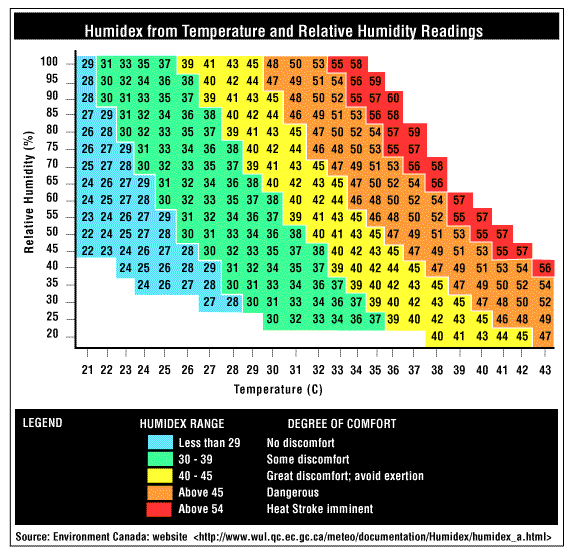Introduction
Humidex has a long history. It originated from Canada in 1965. Canadian meteorologists use it to analyze risks associated with exposure to heat and excessive moisture. They achieve this by bringing together temperature and humidity indices. Compared to temperature readings, humidex is regarded as a better measure of how stifling or stuffy the air feels.
It is reported as a value. It is not a temperature reading. The reason is that it is just an expression of individual experiences. It is an equivalent scale used by the general public to express the effects of warm temperatures and humidity. It is similar to the wind chill index. The tool determines levels of cold. However, humidex describes how hot people feel.
Environmental organizations favor the humidex ratings. They use them to predict instances of unbearable heat and humidity. According to the Meteorological Service of Canada, a humidex range of 20-29 is regarded as comfortable. Discomfort sets in from 30 to 45.
Any value above 45 is regarded as extremely dangerous. Anyone exposed to such conditions may suffer heat stroke. However, it is noted that the relationship between the two concepts is not objective. The reason is that it varies widely between individuals.
Calculating humidex
There are two common methods used in calculating this value. The first is humidex computation formula. The second is humidex chart.
Humidex computation formula
The formula was introduced by researchers at Canada’s Atmospheric Environment Service in 1979. It is used as a standard in Canada. However, varying versions of the formula are used in different parts of the world. The humidex formula is given below:

The dew point temperature is given in Kelvins. Another value used is 5417.7530. It is a constant. It expresses the weight of water molecules. Other constants include latent heat of vaporization and universal gas. The highest humidex value in Canada was recorded in 1961. It stood at 53.4.
Calculating humidex using a chart
The use of a chart is not common. However, it is the most effective method for people with little or no knowledge on the use of the computation formula. The level of humidex is determined by checking the value of current temperature against relative humidity. For instance, if the temperature is 30°C and relative humidity 70%, then Humidex rating will be 42.

A critique of the humidex index
Many environmentalists have criticized the use of the index in such countries as Canada. The critics acknowledge the importance of other indices that illustrate the cold and windy conditions in the country. They argue that even countries with higher humidity and heat levels than Canada do not use the humidex index.
According to them, the index was only developed to create excitement. They compare it to the discovery of the wind-chill index.
Some scientists also argue that creating a formula that quantifies feelings is unscientific. According to them, feelings vary from one person to the other. Other people feel that an index that is a function of two measurements does not provide any additional information on top of the one given by the variables used.
Mathematicians criticize the index by claiming that its formula is illegal and fraudulent. The reason is that the formula uses unscientific methods, such as subtracting scalar quantities from quantizes in millibars.
Conclusion
Humidex is used in many countries for different reasons. For instance, it may be used to determine the conditions in which people are working. It is also used to alert people of the dangers associated with high temperatures and humidity levels.
Many people may disagree with the logic behind the computation and use of the humidex index. However, in spite of this, the index is the most effective way of expressing people’s feelings towards exposure to humidity and high temperatures.
Bibliography
R. Rana, B. Kusy, R. Jurdak, J. Wall, and W. Hu, “Feasibility analysis of using humidex as an indoor thermal comfort predictor,” Energy and Buildings, vol. 64, pp. 17-25, 2013.
D. Charron, Humidex and its use in the workplace. Hamilton, Ont.: Canadian Centre for Occupational Health and Safety, 1989.
J. Masterton and F. Richardson, Humidex: A method of quantifying human discomfort due to excessive heat and humidity. Downsview, Ont.: Environment Canada, Atmospheric Environment, 1979.
W. Santee and R. Wallace, Evaluation of weather service heat indices using the USARIEM Heat Strain Decision Aid (HSDA) model. Ft. Belvoir: Defense Technical Information Center, 2003.
V. Mersereau, A scan of municipal heat/health watch warning systems and hot weather response plans. Ontario, Canada: Clean Air Partnership, 2007.
K. Blazejczyk, Y. Epstein, G. Jendritzky, H. Staiger, and B. Tinz, “Comparison of UTCI to selected thermal indices,” International Journal of Biometeorology, vol. 56, no. 3, pp. 515-535, 2012.
J. Orosa, A. Costa, A. Rondriguez-Fernandez, and G. Roshan, “Effect of climate change on outdoor thermal comfort in humid climates,” Journal of Environmental Health Science and Engineering, vol. 12, p. 46, 2014.